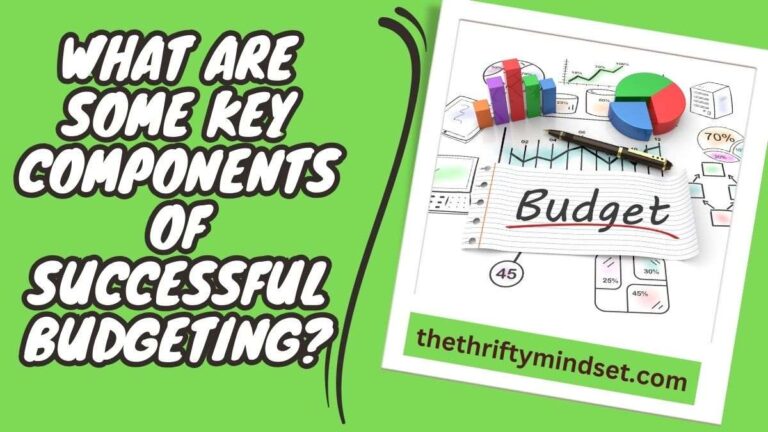In the dance of dollars and dreams, budgeting is your rhythm, guiding each step toward financial harmony. Imagine navigating a maze blindfolded; that’s managing money without a budget. It’s the silent stress that gnaws at your peace, leaving you wondering where each paycheck disappeared.
But fear not! Mastering a few key components can turn this chaos into a choreographed waltz of savings and satisfaction.
We’ll break down the complex symphony of successful budgeting into digestible, actionable notes. From the thrill of setting goals to the sweet victory of debt reduction, we’ll explore practical strategies wrapped in everyday language.
Key components of successful budgeting include setting realistic goals, tracking and categorizing expenses, prioritizing savings, managing debt, adjusting for life changes, and regularly reviewing the budget to ensure it aligns with financial objectives.
Key Components of Successful Budgeting Explained
1. Set Clear and Realistic Goals
Begin by establishing clear, realistic, and attainable financial goals. These could range from short-term objectives like saving for a vacation to long-term goals such as retirement savings. Quantify your goals with specific numbers and timelines to provide direction and motivation.
2. Understand Your Income
Accurately assess all sources of income, including salaries, bonuses, and any passive income streams. Understanding your total income is crucial for creating a budget that reflects what you can truly afford.
3. Track and Categorize Expenses
Keep a detailed record of all your expenses. Categorize them into essentials (rent, utilities, groceries) and non-essentials (dining out, entertainment). This will help you identify areas where you can cut back and allocate funds more effectively.
4. Prioritize Savings
Treat savings as a non-negotiable expense. Determine a percentage of your income to save each month and stick to it. Whether it’s for an emergency fund, retirement, or specific goals, consistent saving is a cornerstone of financial stability.
5. Limit Debt

Minimize and manage your debt effectively. High-interest debts, such as credit card balances, should be paid off as quickly as possible. Understand the terms of your debts and prioritize repayment to reduce interest and fees.
6. Create a Buffer for Unexpected Expenses
Life is unpredictable. Set aside a portion of your budget for unexpected expenses such as medical emergencies or car repairs. This emergency fund will prevent you from derailing your budget when unforeseen costs arise.
7. Adjust for Life Changes
Regularly review and adjust your budget to reflect any significant life changes, such as a new job, moving houses, or changes in family size. A flexible budget is more sustainable and realistic.
8. Invest wisely
Allocate a portion of your income towards investments. Whether it’s stocks, bonds, real estate, or retirement accounts, investing can help grow your wealth over time. Understand your risk tolerance and seek advice if needed.
9. Monitor and Review Regularly
Regularly review your budget and financial progress. Check if you’re meeting your goals and make adjustments as necessary. This might mean revisiting your budget monthly or quarterly.
10. Cut Unnecessary Expenses
Identify and eliminate wasteful spending. This could involve canceling unused subscriptions, reducing dining out, or shopping for better rates on insurance and utilities. Small changes can lead to significant savings over time.
11. Use Tools and Resources

Utilize budgeting tools and resources such as apps like YNAB and Goodbudget, spreadsheets, or financial advisors. These can help simplify the process, provide valuable insights, and keep you accountable.
12. Reward Yourself
Budgeting doesn’t mean you can’t enjoy life. Allocate a small portion of your budget for rewards when you reach your goals. This can help keep you motivated and ensure that your budget is sustainable and enjoyable.
4 Characteristics Of A Successful Budget
1. Realistic and Attainable
A successful budget is grounded in reality. It is based on accurate and current information about income and expenses. The targets set for savings, debt repayment, or investment are achievable, considering the individual’s or organization’s financial situation.
2. Flexible and Adaptable
While a budget should be a guiding document, it also needs to be flexible enough to adapt to unexpected changes in income or expenses. A successful budget allows for adjustments without completely derailing the financial plan. This adaptability is crucial for dealing with life’s uncertainties.
3. Clear and Specific
A successful budget is detailed and specific. It breaks down income and expenses into clear categories, making it easy to track and manage. Specificity helps in identifying exactly where money is coming from and where it’s going, which aids in making informed financial decisions.
4. Goal-Oriented
Every successful budget is built with the end in mind. It is aligned with short-term and long-term financial goals, whether it’s saving for a vacation, paying off debt, or planning for retirement. The budget acts as a roadmap to help reach these goals, providing motivation and a sense of direction.
Conclusion
Successful budgeting is a blend of discipline, foresight, and adaptability. By setting realistic goals, diligently tracking expenses, prioritizing savings and debt management, and regularly reviewing and adjusting your financial plan, you can maintain control over your finances and steadily work towards your economic aspirations.
Remember, a budget is not a constraint but a tool to achieve financial freedom and peace of mind. Embrace these key components, and watch as your budget becomes a powerful ally in your journey toward financial success.
I’m Grayson Watson, your frugal companion and the brain behind this money-saving extravaganza. Strap yourself in, because we’re about to embark on a wallet-friendly adventure like no other. Learn More!

